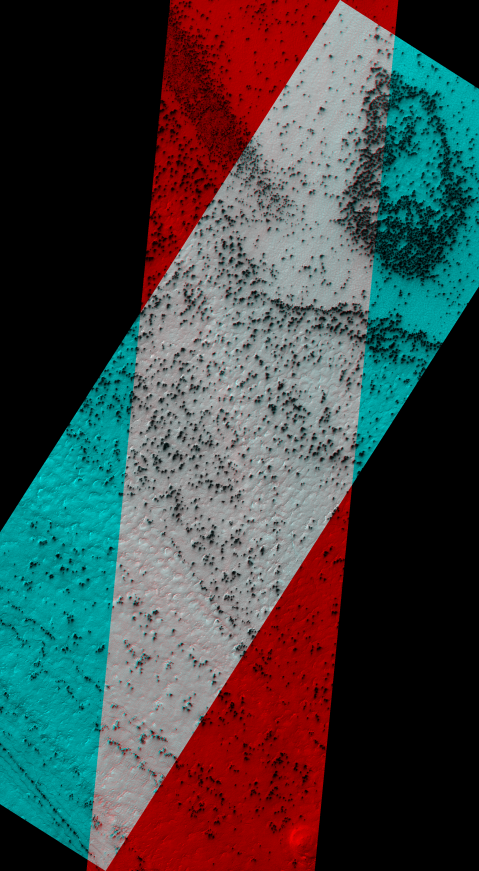Grab your 3-D glasses

Image Credit: NASA/JPL/University of Arizona
http://www.uahirise.org/anaglyph/singula.php?ID=ESP_011351_0945
For orbiting spacecraft a trick with spacecraft orientation can be used to get 3-D information on the terrain of a planetary body. If images of the same region are taken at different angles, these images (usually taken as two images called stereo pairs) can be combined to make stereo or 3-D images. This is the same technique our brain uses to generate depth perception. This is because our eyes are spaced apart, each eye has a slightly different view of the things in front of us. Our brains automatically combine the information from the two images to gauge the distances to and construct the sizes of objects in our vision.
The HiRISE team does this by commanding the Mars Reconnaissance Orbiter to point such that the HiRISE camera rolls either left or right of the ground track of the spacecraft as its above a target region. This technique has been used to created digital terrain and elevation models of the landing sites for the Mars rovers and other areas of interest on Mars. Anya from the Planet Four team is working on analyzing a stereo pair of the spiders as she mentioned in one of our previous live chats.
A popular way to view a stereo pair from orbiting spacecraft is in what is called a stereo anaglyph where the images are combined such that there is one image for the left eye and one image for the right eye. The left looking image is displayed in red and the right looking image is displayed in blue. If you have a pair of red-blue 3-D glasses, you should see the the above image in 3-D.
I happened to come across an analgyph (the image above) of the seasonal fans taken during the monitoring of the South Pole in Season 2, and I thought I’d share. The full resolution 3-D image can be downloaded from here , and you explore the full-res image with zooming and scrolling capability with the HiView tool. Grab your 3-D glasses and enjoy!
7 responses to “Grab your 3-D glasses”
Trackbacks / Pingbacks
- - December 28, 2014
- - May 1, 2015

Thanks for the 3-D shot. Unfortunately this is my 1st 3-D image that I am not able to see in 3-D. Beats me why. I never had failed to see 3-D images in 3-D before this one. Drat.
When looking at these 3-D images do you all have the marking data to determine which features were seen and ID’d correctly? That is are the fans and blotches just that or simply sublimation mis-identified as a blotch for example. If so, can your software be coded to filter out these type of errors to make the counting of fans and blotches more accurate?
You might want to try the full hi-res image. The top image is a reduced resolution image.
We’re still working on data analysis. I haven’t checked to see if these two images were included in the season 2 data we had on the site (I’m guessing they are), but to determine which ones are correctly ID-ed for the whole dataset having the 3-D imaging doesn’t help very much for that. What we’ll likely do is compare to a subset of images the science team have classified.
Cheers,
~Meg
Hi Meg — Thanks for the reply and suggestion. I tried and I just can’t see it. I did glance at other 3-D images from the same site and I saw those instantly. I’ll try another computer in the next day or so with different software too and see if that helps.
Hi Meg — I tried but that did not help me. Oh well. It must be my eyes even though I do not have a problem looking at 3-D images of everything else. Thanks again.